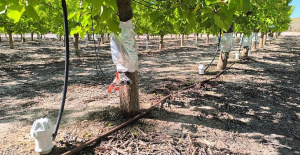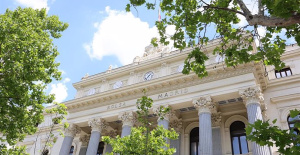He identifies them as a radical nucleus willing to pursue the independence of Catalonia with violence
MADRID, 21 Oct. (EUROPA PRESS) -
The judge of the National Court (AN) Manuel García Castellón has concluded the summary of the case directed against the alleged members of a radical nucleus of the Defense Committees of the Republic (CDR) who were willing to use violence to achieve independence of Catalonia, thereby bringing the twelve prosecuted for an alleged crime of belonging to a terrorist organization closer to trial.
In a Thursday order, to which Europa Press has had access, the head of the Central Court of Instruction Number 6 agrees to put an end to his investigations, "once the procedures that have been deemed necessary and useful have been carried out" and "on verifying that the summary investigation has seen its purpose fulfilled by identifying those responsible for the act, qualifying the crime and assuring the persons and property that must respond to it.
From now on, García Castellón explains that "the conclusion order will be notified to all parties, summoning them to appear before the competent court or hearing to hear the oral trial."
It was on September 14, 2021 when the instructor prosecuted the thirteen investigated by 'Operation Judas' for said crime and nine of them were also charged with possession, deposit and manufacture of explosive and flammable substances or devices of a terrorist nature. Later, he closed the case for one for medical reasons, so the procedure continues only with respect to twelve.
In the indictment, the judge explained that this group formed within the CDRs the so-called Tactical Response Team (ERT), a cell made up of a radicalized nucleus made up of individuals from different CDRs.
The creation of the ERT would be motivated by the need to have within the CDR a clandestine group made up of highly trusted individuals who showed themselves to be totally dedicated to "the cause" in order to entrust them with the most sensitive actions.
All those investigated, García Castellón pointed out, shared ideological principles and an objective: to achieve the independence of Catalonia, using violence at its best.
According to the judicial account, the members of the ERT would have had an active participation in some of the most forceful actions that the CDRs have carried out to date, such as cutting roads, erecting toll barriers or pouring oil on the section of the C -55 where the procession that transferred those convicted of the 'procés' from the Lledoners prison had to pass.
They would also have ambitious plans. Thus, they would have assumed the commission that they would have received from the so-called 'Catalan CNI' to provide the necessary logistics infrastructure to occupy the Parliament of Catalonia, defend it once it was taken and remain there for at least a week.
They would enter through the front door, because access would supposedly be facilitated from the inside, and they would communicate with the outside through an undetectable telecommunications network that they would set up themselves.
Together with a small group of people, they would cooperate with the 'Catalan CNI' to rent houses and premises that would allow them to establish "intendencia" bases, setting up long-distance antennas for said telecommunications network. All this with a budget of about 6,000 euros.
In this way, the twelve defendants, taking advantage of the contacts fostered by their militancy in the CDR, "constituted themselves into a cell that raised the intensity and nature of the actions carried out to a higher level."
The judge underlined that they would have gone beyond the CDR to set up "a parallel terrorist organization, clandestine and stable, whose objective would be to carry out violent actions or attacks against previously selected targets using explosives and/or incendiary substances manufactured in the two clandestine laboratories that the organization itself had installed in two private homes".
In addition to the Parliament, they had other objectives in their sights. They had made surveillance, photographs and videos of various facilities, among which the instructor mentions the Naval Command, the Military Government and the Government Delegation of Barcelona and the Prosecutor's Office of the Superior Court of Justice of Catalonia.
García Castellón paid special attention to reconnaissance of the perimeter of the barracks of the Barcelona Civil Guard Command, located in the municipality of San Andreu de la Barca.
Likewise, it highlighted that they would have carried out different searches on the Internet through their devices for data related to people linked to political parties opposed to independence and an agent of the Mossos d'Esquadra.

 Exploring Cardano: Inner Workings and Advantages of this Cryptocurrency
Exploring Cardano: Inner Workings and Advantages of this Cryptocurrency Seville.- Economy.- Innova.- STSA inaugurates its new painting and sealing hangar in San Pablo, for 18 million
Seville.- Economy.- Innova.- STSA inaugurates its new painting and sealing hangar in San Pablo, for 18 million Innova.- More than 300 volunteers join the Andalucía Compromiso Digital network in one month to facilitate access to ICT
Innova.- More than 300 volunteers join the Andalucía Compromiso Digital network in one month to facilitate access to ICT Innova.-AMP.- Ayesa acquires 51% of Sadiel, which will create new technological engineering products and expand markets
Innova.-AMP.- Ayesa acquires 51% of Sadiel, which will create new technological engineering products and expand markets Eurovision disqualifies the Netherlands for "inappropriate behavior" following an "incident" after the semi-final
Eurovision disqualifies the Netherlands for "inappropriate behavior" following an "incident" after the semi-final Jorge Martín signs a record pole in Le Mans against Bagnaia
Jorge Martín signs a record pole in Le Mans against Bagnaia Russia redoubles its attacks on Kharkiv during the last hours and launches more than 120 bombings on the front
Russia redoubles its attacks on Kharkiv during the last hours and launches more than 120 bombings on the front Israel urges residents of ten other areas of Rafah to leave the area immediately
Israel urges residents of ten other areas of Rafah to leave the area immediately How Blockchain in being used to shape the future
How Blockchain in being used to shape the future Not just BTC and ETH: Here Are Some More Interesting Coins Worth Focusing on
Not just BTC and ETH: Here Are Some More Interesting Coins Worth Focusing on The CSN finances an IFIC project to evaluate a technology that improves nuclear waste management
The CSN finances an IFIC project to evaluate a technology that improves nuclear waste management Expociència expects to receive more than 4,000 visitors in the Science Park of the University of Valencia
Expociència expects to receive more than 4,000 visitors in the Science Park of the University of Valencia They develop devices for the precise diagnosis of cancer patients
They develop devices for the precise diagnosis of cancer patients UMH researchers are working on a high-quality apricot crop that requires less irrigation water
UMH researchers are working on a high-quality apricot crop that requires less irrigation water A million people demonstrate in France against Macron's pension reform
A million people demonstrate in France against Macron's pension reform Russia launches several missiles against "critical infrastructure" in the city of Zaporizhia
Russia launches several missiles against "critical infrastructure" in the city of Zaporizhia A "procession" remembers the dead of the Calabria shipwreck as bodies continue to wash up on the shore
A "procession" remembers the dead of the Calabria shipwreck as bodies continue to wash up on the shore Prison sentences handed down for three prominent Hong Kong pro-democracy activists
Prison sentences handed down for three prominent Hong Kong pro-democracy activists ETH continues to leave trading platforms, Ethereum balance on exchanges lowest in 3 years
ETH continues to leave trading platforms, Ethereum balance on exchanges lowest in 3 years Investors invest $450 million in Consensys, Ethereum incubator now valued at $7 billion
Investors invest $450 million in Consensys, Ethereum incubator now valued at $7 billion Alchemy Integrates Ethereum L2 Product Starknet to Enhance Web3 Scalability at a Price 100x Lower Than L1 Fees
Alchemy Integrates Ethereum L2 Product Starknet to Enhance Web3 Scalability at a Price 100x Lower Than L1 Fees Mining Report: Bitcoin's Electricity Consumption Declines by 25% in Q1 2022
Mining Report: Bitcoin's Electricity Consumption Declines by 25% in Q1 2022 Oil-to-Bitcoin Mining Firm Crusoe Energy Systems Raised $505 Million
Oil-to-Bitcoin Mining Firm Crusoe Energy Systems Raised $505 Million Microbt reveals the latest Bitcoin mining rigs -- Machines produce up to 126 TH/s with custom 5nm chip design
Microbt reveals the latest Bitcoin mining rigs -- Machines produce up to 126 TH/s with custom 5nm chip design Bitcoin's Mining Difficulty Hits a Lifetime High, With More Than 90% of BTC Supply Issued
Bitcoin's Mining Difficulty Hits a Lifetime High, With More Than 90% of BTC Supply Issued The Biggest Movers are Near, EOS, and RUNE during Friday's Selloff
The Biggest Movers are Near, EOS, and RUNE during Friday's Selloff Global Markets Spooked by a Hawkish Fed and Covid, Stocks and Crypto Gain After Musk Buys Twitter
Global Markets Spooked by a Hawkish Fed and Covid, Stocks and Crypto Gain After Musk Buys Twitter Bitso to offset carbon emissions from the Trading Platform's ERC20, ETH, and BTC Transactions
Bitso to offset carbon emissions from the Trading Platform's ERC20, ETH, and BTC Transactions Draftkings Announces 2022 College Hoops NFT Selection for March Madness
Draftkings Announces 2022 College Hoops NFT Selection for March Madness
























